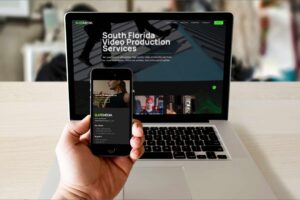When discussing projects with potential clients, the topic of having a blog often arises. If you’re a small business owner contemplating a professionally built website and considering a blog, this brief overview can aid your decision-making.
The importance of websites for businesses
In today’s digital age, having a strong online presence is vital for businesses of all sizes. Your website serves as your virtual storefront, offering potential customers a glimpse into what you have to offer.
For small local businesses or global enterprises, a well-designed website is a potent tool for growth, trust, and credibility.
Overview of a small business blog’s role in websites
The blog’s role in websites has evolved over the years and is now recognized as a valuable tool for achieving various objectives. They provide an avenue for businesses to share informative, educational, or entertaining content with their audience. Whether it’s industry insights, how-to guides, news updates, or customer stories, a blog keeps visitors informed and engaged.
Blogs encourage interaction and engagement with your audience. Readers can leave comments, ask questions, and share their thoughts, fostering a sense of community around your brand. They can also serve as a funnel to convert visitors into customers. By providing valuable information, you can guide your audience through the buying journey, leading to increased sales and conversions.

What is a Blog?
If you’re new to the game, a blog, which is short for ‘weblog’ (web-log) is an online journal where people or organizations post articles on a regular basis in a chronological order. A small business blog typically consists of a number of entries, each of which may include text, pictures, videos, or a mix of other embedded assets. It can discuss many different subjects, such as news, hobbies, professional views, and personal experiences. A blog’s informal, conversational style is its unique strength, allowing bloggers to engage with their audience on social media and in comments. It offers a flexible platform for expressing ideas, knowledge, and artistic creations to a global audience.
A number of unique features distinguish blogs from other traditional media formats. First of all, they frequently undergo updates, offering a steady stream of new information. In addition, blogs facilitate communication and build a feeling of community between authors and readers. Direct communication is made possible by comment sections (optional), which transform blogging into a two-way dialogue.
What is the Ultimate Purpose of a Blog?
Informative content for visitors
This article is a prime example of “informative content”. My visitors are usually small business owners either looking to build their own website or have me build one for them. Writing these articles helps build confidence in readers in hopes to turn a percentage of them into clients.
Establishing authority and expertise
Imagine being a local plumber or computer repair shop and writing articles about recent repair methods, technology, or recounting a recent challenging project. A small business blog is a great way to establish authority and expertise. It displays that your company isn’t stagnant and stays up to date with current trends and methodologies, perhaps even leading those trends and new methods!

Driving organic traffic
Traffic that originates from search engines like Google, Bing, or Yahoo is referred to as organic traffic. It might be challenging to generate organic traffic since it demands that people are aware of your company’s identity and/or the goods and services you provide.
Because organic traffic contains more qualified prospective leads than any other, it has a distinct edge over all others. If organic traffic contacts your small business, it’s likely because they came across you through word-of-mouth or a simple search. Using blog articles is a terrific approach to get business because it’s great for Local SEO ranking, brand awareness, and conversions.
Engaging with the audience
Quality over quality! It’s important to be consistent when writing articles – creating syndication; but this doesn’t mean you have to post twice per week! You do what you can handle or outsource it, even if that means you post once per month to start for the first year.
A great example of a small business blog is the one found on boulevardcarts.com. In fact, they post once per quarter because they understand how important it is for local organic Google ranking. It’s also important that they build a rapport within their market because it’s peppered with competitors that have been in business for quite some time – the caveat is that these competitors don’t have blogs. So their growth has grown faster than it would have had it not incorporated a blog.
In order to engage your audience, you need to understand your target and deliver content they will enjoy. I suggest talking with your clients, getting a feel for what interests them or what questions they seem to ask more than often. These are a couple of great ways to come up with writing ideas.
Turning visitors into conversions
It can be a labor of love, but worth it once momentum kicks in. Turning a visitor into a conversion can mean a variety of things, it merely depends on what your specific goal is:
- Sale (product, scheduled Service, membership, etc.)
- Lead (contact information, Email, etc.)
- CTA (button-click / link-click)
- Page Visit (reaching a particular page)
Which Websites Usually Have a Blog?
A. eCommerce Sites
B. Service-based Businesses
C. Small Retail Businesses
D. News and Media Websites
E. Personal Brands and Influencers
Pros and Cons of Having a Blog
Pros
- Improved SEO
- Building brand awareness
- Establishing authority
- Audience engagement
- Content repurposing
Cons
- Time and effort required
- Consistency challenges
- Content quality concerns
- Competition

What is Involved in Maintaining a Blog?
Topics and Keywords Research
Understanding which topics and keywords are most relevant to your target reader / market is essential. It helps to get in touch with some of your closest clients and have a conversation about what curiosities they have, what would get them to visit the website other than the typical scenario, what keywords they used to find you, etc. You want to press these hot buttons.
Visual Content (images, videos)
Without images and/or video, let’s say ‘multimedia’, your articles will engage less and rank less. Videos can be uploaded to YouTube (which helps cast a wider net to drive more traffic to a website) and embed those videos to their respective articles.
Small business blog postings using images accomplish several important functions. First of all, they improve the content’s visual attractiveness by drawing the reader in and breaking up lengthy text passages to make it seem more approachable and interesting. Second, pictures make material easier to grasp and more comprehensible for readers by helping them visualize complicated ideas. Additionally, as people tend to recall visual material better than text alone, adding graphics to your blog article makes it more memorable and increases retention.
Finally, search engines take into account photos when ranking material, which results in advantages from SEO.
Improving your blog’s SEO through relevant alt text and captions for images can boost its visibility in search results. In summary, careful image selection enhances the overall appearance of your blog and aids readers in better understanding, retention, and online discovery of your content.
Writing and Editing
As you can imagine, you don’t just start writing. There’s a process of brainstorming, researching, outlining, drafting, reviewing, altering, and publishing. Again, the purpose of a small business blog is to greatly improve local SEO ranking, engagement of readers, and hopefully turning them into clients. In order to accomplish this, it’s important to keep in mind your keywords and long-tail-keywords.
The costs associated with this method is simply…your time.
Publishing and Scheduling

Establishing a content calendar is essential for small business blogs, providing a structured approach to planning topics, publishing dates, and relevant events. This not only ensures a consistent flow of content but also signals to search engines the site’s active relevance.
Choosing the right posting frequency—weekly, bi-weekly, or monthly—is vital for audience engagement and a dynamic online presence. Utilizing scheduling tools, integrated into platforms like WordPress or through third-party apps like Buffer and Hootsuite, streamlines the publishing process, boosting efficiency in small business blog management.
Consistency in voice and style is imperative for small business blogs, fostering brand identity and audience engagement. Achieving this uniformity, regardless of tone, contributes to the blog’s professionalism. Optimization for search engines involves seamlessly incorporating keywords and crafting compelling meta elements. Cross-linking within blog posts encourages exploration of additional content, enhancing the user experience and distributing page authority. Regularly monitoring and updating older posts maintain their relevance, signaling to search engines ongoing site value. Visual appeal is heightened through high-quality images, infographics, and videos, aiding effective information conveyance. Ensuring user-friendly formatting, with subheadings and bullet points, enhances readability and contributes to a clean, visually appealing layout for an improved user experience.
Sharing and Interacting with your Audience
This is the distribution of your published work on social media platforms like Facebook, Instagram, LinkedIn, etc. Monitoring posts for comments from followers, relevant topics, and hashtags can create opportunities by sparking engaging conversations, generating questions, building relationships, and demonstrating to new visitors that your business is active and engaged.




